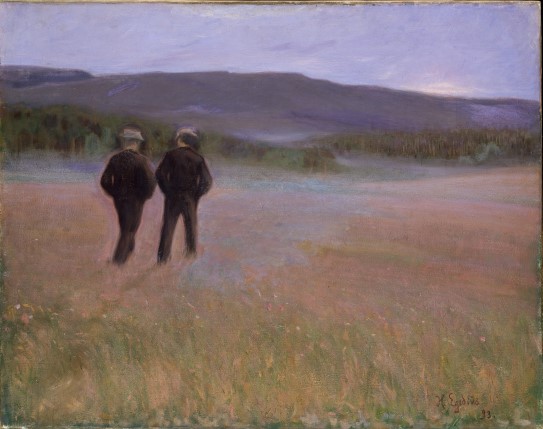Saturday Evening
Halfdan Egedius
Transcription
Widar Halén:
And it was kind of like an icon for us, this little painting here. When you saw it, you understood that “ok then, someone in this house is homosexual”. That's what we thought... It was like a sign.
Narrator:
Retired art historian and long-time employee at the National Museum, Widar Halén, is a little extra fond of the painter Halfdan Egedius' artwork "Saturday Evening" from 1893. Halén - and many with him - have interpreted this artwork as a depiction of queer love, based on the artist's close friendship with the Telemark painter Torleiv Stadskleiv.
Widar Halén:
It was certainly one of those paintings that I admired, and which had something in it that you recognized in yourself, because you saw this closeness between the two, and you saw that there was something very special about that friendship, and this glow around the figures, which makes you realize that here there is something very special the artist wanted to say. And it hasn't been said very openly in Norwegian art history before, so it's nice that this is coming out now.
Narrator:
The men in the artwork turn their backs, and some choose to interpret that as if they want to hide something, as if the two have a shared secret.
They find each other regardless of the morality of the time. Halfdan Egedius was only 21 years old, but the correspondence between him and Stadskleiv, which is preserved in the National Library, testifies to a close relationship, to restrained love and longing.
Widar Halén:
I am a little moved by this story. It is very special. So, it has precisely to do with that intimate relationship, then, between two men, which you don't otherwise think about when you see it in the museum.
Narrator:
Since the 1960s, when it was still a crime to be homosexual in Norway, postcards and prints of "Saturday Evening" were hung up on walls in the homes of homosexuals as an icon of free love. Many people still do this…
Widar Halén:
Yes, I had it from my youth in the 60s and 70s, as a postcard, as I’m also gay. And it was often hung in the hall or in the entrance of a home, so you saw it immediately when you entered. And then the other person, who perhaps was also homosexual but married, understood that here is an ally, here is someone I can possibly open up to. So that's how it was used, deliberately.